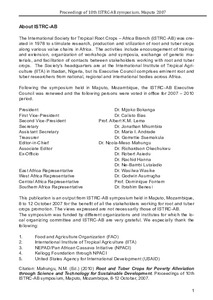| dc.contributor.author | Ssemakula, G.N. |
| dc.contributor.author | Dixon, Alfred G.O. |
| dc.contributor.author | Maziya-Dixon, B. |
| dc.date.accessioned | 2019-12-04T11:11:00Z |
| dc.date.available | 2019-12-04T11:11:00Z |
| dc.date.issued | 2010 |
| dc.identifier.citation | Ssemakula, G., Dixon, A.G.O. & Maziya-Dixon, B. (2010). Towards improving the nutritional quality of cassava: progress in the genetic enhancement of carotenoids, iron, zinc, and protein levels. In Proceedings of the 10th Symposium of ISTRC-AB in Mozambique: root and tuber crops for poverty alleviation through science and technology for sustainable development (p. 231-241), 8-12 October, Maputo. |
| dc.identifier.isbn | 99951-60-00-5 |
| dc.identifier.uri | https://hdl.handle.net/20.500.12478/2322 |
| dc.description.abstract | Though cassava (Manihot esculenta Crantz) is a staple for many poor people in Africa, it has major nutritional disadvantages. The tuberous root has very low levels of essential nutrients. Consequently, malnutrition is widespread among the people who depend on as a staple in their diet. Breeding cassava for enhanced nutritional quality and making such biofortified varieties available to endusers could help prevent related deficiencies. This paper presents experiences and progress in the genetic enhancement of nutrients in cassava at the International Institute of Tropical Agriculture. Selected cassava clones were screened for levels of β-carotene, iron, zinc, and protein; useful variation was in levels of the nutrients were identified that have provided the genetic basis for their enhancement. From baseline concentrations of 4μ/g (β-carotene), 9mg/kg (iron and zinc), and 4% (protein), levels have risen to > 12μ/g (β-carotene), >40mg/kg (iron), >25mg/kg (zinc), and > 20% (protein) through recombination and selection. To broaden the genetic base, nutrient rich germplasm was sourced from Latin America, south-east Asia, and a few countries in Africa. This has contributed to an increase of more than 100% nutrient levels. Promising clones are evaluated in multilocational trials for agronomic characteristics and stability of nutrient levels. So far, our results show that carotene concentration in cassava is a stable trait, suggesting that selection for the trait can be reliably done at a single location. Some genotypes with good performance and are stable for both carotene levels and yield have been identified. Polyploid breeding for the enhancement of carotene levels is also being explored; preliminary results show that carotenoid levels are higher in tetraploids than in their diploid counterparts. Attempts to combine high levels of protein, iron, zinc, and carotene into single genotypes are underway. |
| dc.description.sponsorship | HarvestPlus |
| dc.format.extent | 231-241 |
| dc.language.iso | en |
| dc.publisher | International Institute of Tropical Agriculture |
| dc.subject | Nutrition |
| dc.subject | Cassava |
| dc.subject | Genetics |
| dc.subject | Carotenoids |
| dc.subject | Iron |
| dc.subject | Zinc |
| dc.subject | Proteins |
| dc.title | Towards improving the nutritional quality of cassava: progress in the genetic enhancement of carotenoids, iron, zinc, and protein levels |
| dc.type | Conference Paper |
| dc.description.version | Peer Review |
| cg.contributor.affiliation | International Institute of Tropical Agriculture |
| cg.coverage.region | Africa |
| cg.coverage.region | Central Africa |
| cg.coverage.region | East Africa |
| cg.coverage.region | Southern Africa |
| cg.coverage.region | West Africa |
| cg.coverage.country | Burkina Faso |
| cg.coverage.country | Congo, Dr |
| cg.coverage.country | Ghana |
| cg.coverage.country | Malawi |
| cg.coverage.country | Mozambique |
| cg.coverage.country | Tanzania |
| cg.coverage.country | Uganda |
| cg.coverage.country | Zambia |
| cg.authorship.types | CGIAR single centre |
| cg.iitasubject | Cassava |
| cg.iitasubject | Nutrition |
| cg.howpublished | Formally Published |
| cg.publicationplace | Ibadan, Nigeria |
| cg.accessibilitystatus | Limited Access |
| local.dspaceid | 92023 |
| cg.targetaudience | Scientists |

